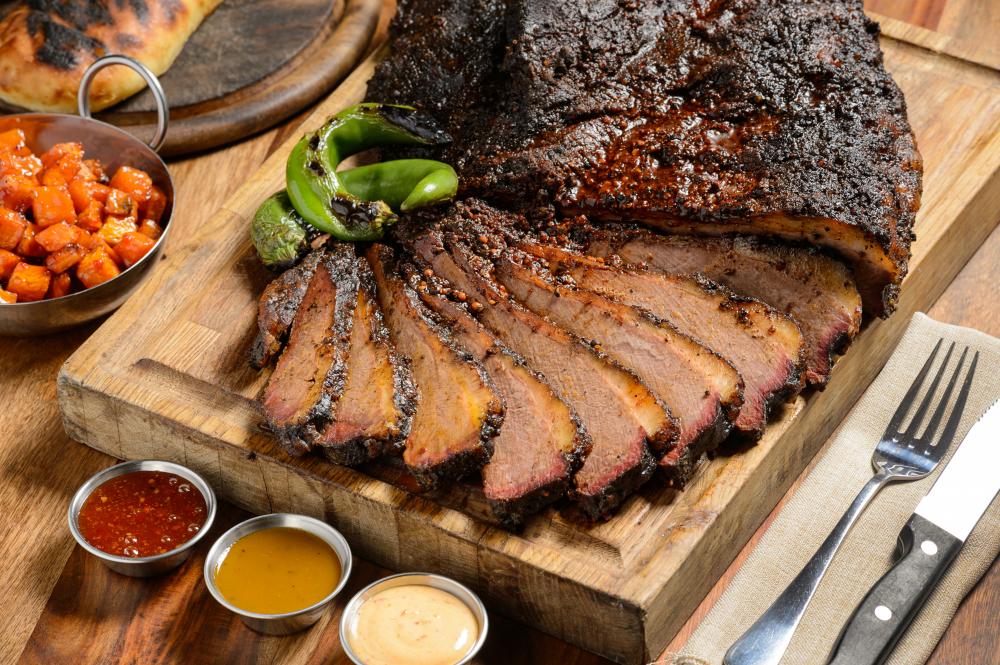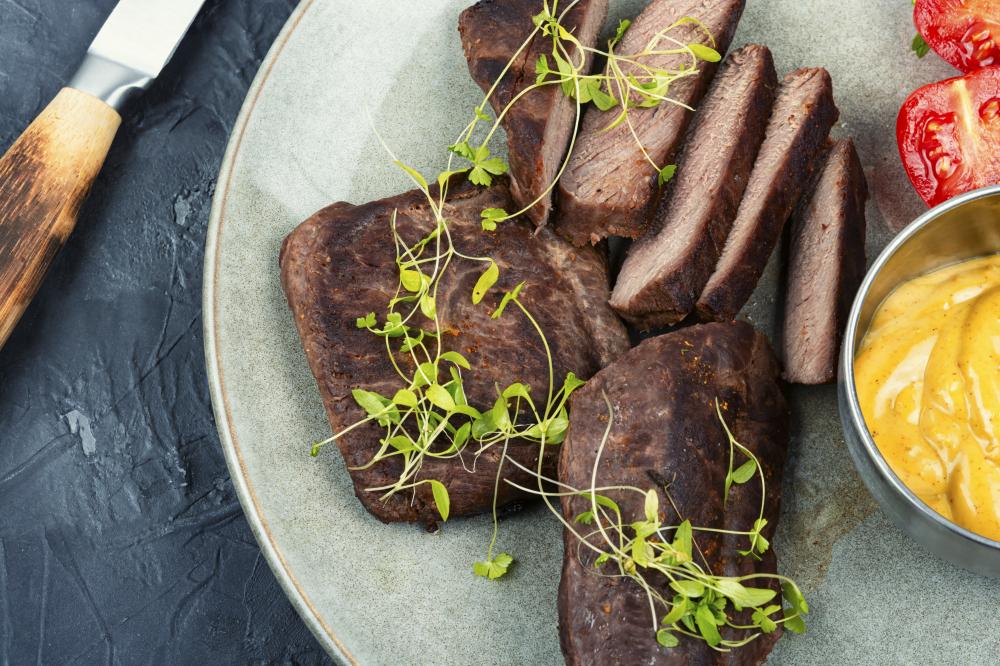
Understanding Brisket Stall Temperature
At Brisket Pro, we dive deep into the heart of brisket cooking, where every BBQ enthusiast comes across the notorious brisket stall temperature. This phenomenon occurs during the long, low, and slow cooking process, typically manifesting when the brisket’s internal temperature hits the 150°F-170°F range. Here, we’ll explore why this stall happens and how to navigate it to achieve brisket perfection.
Why Does the Stall Happen?
Essentially, the brisket stall temperature is a plateau where the meat stops rising in temperature. This occurs due to evaporative cooling; as the brisket cooks, moisture on its surface evaporates, cooling the meat down and counteracting the heat from your smoker or grill. Think of it as the brisket’s way of sweating to cool off in the Texas heat. It can be a test of patience, but understanding this process is crucial in achieving that melt-in-your-mouth texture.
Navigating the Stall
To conquer the brisket stall temperature, many pitmasters employ a technique known as the “Texas Crutch.” This involves wrapping the brisket in butcher paper or aluminum foil once it reaches the stall temperature. This practice not only helps to push through the stall by trapping in heat and moisture but also preserves the brisket’s juicy tenderness. Let’s break down the pros and cons of each wrapping material.
Choosing Your Wrap
- Butcher Paper: It’s breathable, allowing smoke to continue flavoring the brisket while retaining enough moisture to push through the stall.
- Aluminum Foil: Creates a tighter seal than butcher paper, trapping more steam and accelerating the cooking process. However, it might soften the bark.
The decision between butcher paper and aluminum foil depends on your preference for bark texture and cooking time. At Brisket Pro, we’ve tinkered with both, finding that each has its place depending on the desired outcome of the cook.
Personal Insights on Brisket Stall Temperature
Through countless brisket adventures, I’ve learned that the stall is not just a hurdle but an opportunity. It’s the period where brisket transforms, developing flavors and textures that define exceptional BBQ. Once, during a cook-off in Seguin, I wrapped my brisket at a precise 165°F, and the result was a succulent brisket with a bark that was just right. It was a reminder that patience and technique go hand in hand in the art of brisket cooking.
Another strategy I’ve employed is adjusting the smoker’s temperature. A slight increase can help the brisket push through the stall period faster, but it’s a balancing act. Too high, and you risk drying out the meat; too low, and you’re in for an extended cook. It’s about finding that sweet spot, where the brisket continues to cook gently, soaking up smoke and developing a complex flavor profile.
Experimentation and experience have taught me that every brisket is a journey. The brisket stall temperature is a phase where the meat “rests” in the smoke, slowly edging towards perfection. Embracing this stage rather than fighting it has led to some of my most memorable brisket successes.
Tips for Overcoming the Stall
Monitoring Temperature: Use a reliable wireless meat thermometer to keep an eye on your brisket’s internal temperature without constantly opening the smoker.
Wrapping Technique: Master the art of wrapping your brisket at the right moment. Too early and you lose that prized bark; too late and the stall could extend your cook time significantly.
Staying Patient: Brisket cooking is a marathon, not a sprint. The stall is just one of the milestones along the way to achieving a deliciously smoked brisket.
At Brisket Pro, we’ve faced and embraced the brisket stall temperature countless times. Each cook is a lesson in patience, technique, and the pursuit of BBQ excellence. Remember, the stall is not a stop sign; it’s a sign that your brisket is on its way to greatness. With the right approach, you can navigate the brisket stall temperature like a pro, resulting in a brisket that’s worth every minute of the wait.

Understanding Brisket Internal Temp
Here at Brisket Pro, we’re all about diving deep into the heart of brisket cooking, exploring every nuance from cut to cuisine. A critical element that often comes into play is the brisket internal temp – a beacon guiding us to that perfect tenderness and flavor that makes brisket so beloved. Knowing the exact internal temperature needed for brisket can be a game-changer, enhancing not only the taste but also ensuring a safety standard is met.
The magic number we often refer to is 195°F (about 91°C). This is not just a number pulled from thin air; it’s the sweet spot where collagen within the meat breaks down into gelatin, imparting brisket with that mouthwatering, fall-apart texture. However, brisket internal temp can be a bit of a moving target, with some experts suggesting a range anywhere between 195°F to 203°F. This variance accounts for personal preference in texture and the specific characteristics of each piece of meat.
Our journey through countless briskets has shown that while the recommended temperature is a great guideline, there’s also merit in the “feel” method. This involves inserting a probe into the brisket; if it slides in with little resistance, akin to a hot knife through butter, your brisket is typically done. Many pitmasters swear by this method, using it as a complement to their trusty thermometers.
Navigating The Stall
One phenomenon that catches many beginners off guard is the brisket stall. This occurs when the brisket internal temp seems to hit a plateau, often around 150°F to 160°F, not rising for several hours. At Brisket Pro, we view this as a crucial transformation phase, where patience truly becomes a virtue. The stall is the result of evaporative cooling, similar to how sweating cools the body. It’s a sign that your brisket is slowly but surely on its way to perfection.
To combat the stall without losing your cool, there are a couple of tactics you can employ. Wrapping the brisket in butcher paper or aluminum foil – affectionately known as the Texas Crutch – can help push past this phase by trapping heat and moisture. It’s a delicate balance, though; you want to preserve the moist environment without steaming the brisket too much and softening that gorgeous bark you’ve worked so hard to develop.
Another technique is to simply allow more time. Adjusting your expectations and schedule can sometimes be the best approach, embracing the low and slow philosophy at the heart of great BBQ. Remember, each brisket is unique and may require a slightly varied approach. Through experience, you’ll learn to read these subtle cues and adjust your methods accordingly.
Achieving Perfection
Reaching that coveted brisket internal temp is part art, part science. It requires not only a good thermometer but also an understanding of your specific equipment, the meat itself, and environmental factors like weather. At Brisket Pro, we encourage a holistic approach, considering all these variables as you aim for that perfect brisket internal temp.
Remember, resting your brisket post-cooking is just as crucial as the cook itself. Allowing the brisket to rest for at least an hour lets the juices redistribute throughout the meat, ensuring that each slice is as delicious as the next. This often overlooked step is where good brisket becomes great.
Finally, we encourage all brisket enthusiasts to keep a detailed log of their cooks. Note the size and cut of the brisket, the cooker used, weather conditions, and of course, the brisket internal temp at various stages. This not only helps in refining your process but also provides invaluable insights for future cooks. After all, in the world of brisket smoking, every little bit of knowledge contributes to your growth as a pitmaster.
- Start with understanding the importance of the 195°F to 203°F range for brisket internal temp.
- Learn to navigate the stall phase with patience and strategic techniques like the Texas Crutch.
- Keep a detailed log of your cooking process for continuous improvement.
The Art of Brisket Wrapping
As the team behind Brisket Pro, we’ve dedicated countless hours to mastering the craft of brisket preparation. One pivotal aspect we’ve encountered is knowing when to wrap brisket. This technique, though seemingly simple, can significantly influence the outcome of your BBQ. Wrapping brisket is not just about keeping it moist; it’s also about enhancing flavor and achieving that perfect bark that BBQ enthusiasts cherish.
When to wrap brisket is a question that often surfaces among our readers. Typically, the ideal moment is when the brisket’s internal temperature hits between 150-170 degrees Fahrenheit. This range is crucial as it’s when the brisket enters the stall phase, where its temperature plateaus. Wrapping at this juncture helps to break through the stall, allowing the brisket to continue cooking efficiently while retaining its juiciness.
Our firsthand experiences and experiments have shown that both aluminum foil and butcher paper can be effective, each offering distinct advantages. Foil excels in trapping moisture, essentially braising the brisket in its juices, which accelerates the cooking process. Butcher paper, on the other hand, is breathable, permitting smoke to continue influencing the brisket’s flavor while also preserving the bark’s integrity. The choice between the two often boils down to personal preference and the desired end result.
Benefits of Brisket Wrapping
Juiciness: Wrapping brisket seals in its natural juices, preventing the meat from drying out during the lengthy smoking process. This ensures each slice is succulent and full of flavor.
Time Efficiency: By insulating the brisket, wrapping speeds up the cooking time. It’s a game-changer for those looking to shave off a bit of the wait time without sacrificing the meat’s quality.
Tenderization: The process of wrapping helps in tenderizing the brisket. The trapped heat and moisture work together to break down the connective tissues, resulting in melt-in-your-mouth tenderness that’s hard to achieve otherwise.
Enhanced Bark: A concern for many is whether wrapping will jeopardize the bark’s development. However, when executed correctly, wrapping can preserve and even enhance the bark by absorbing additional flavors from the rubs and seasonings, creating a more complex taste profile.
Choosing to wrap your brisket is a strategic step in the cooking process that can make or break your BBQ. At Brisket Pro, we emphasize the importance of understanding why you’re wrapping, in addition to knowing when to wrap brisket. It’s these nuances that transform good brisket into great brisket.
Personal Insights on Brisket Wrapping
Through years of trial and error, we’ve developed a deep appreciation for the subtleties of brisket preparation. Each brisket tells a story, influenced by factors such as the cut’s marbling, the smoker’s temperature, and yes, the decision of when to wrap brisket. Our journey has taught us that patience and attention to detail are non-negotiables in the quest for brisket perfection.
In our community of BBQ enthusiasts, debates about the “right” way to wrap brisket abound. Some swear by the traditional method of using aluminum foil, while others advocate for the nuanced flavor enhancements offered by butcher paper. We encourage experimentation, as discovering your preferred method is part of the joy of BBQ.
One less-discussed aspect of wrapping is the impact of different seasoning blends on the brisket’s final taste. Experimenting with various rubs before wrapping has led us to some delightful flavor combinations. It’s a testament to the versatility of brisket and the endless opportunities for creativity within the BBQ craft.
At Brisket Pro, we’re committed to sharing our knowledge, experiences, and passion for all things brisket. Whether you’re a seasoned pitmaster or a novice smoker, understanding when to wrap brisket and the principles behind it is essential. It’s these details that elevate your brisket from merely good to truly extraordinary.

How long does a stall last on a brisket?
Oh, the brisket stall. It’s akin to a rites of passage for us at Brisket Pro, and it can test even the most patient pitmasters among us. Typically, a brisket stall can last anywhere from a couple of hours to, in some extreme cases, upwards of six hours. However, it’s not just about duration; it’s about what’s happening inside that brisket. You see, during this period, your brisket is sweating out moisture, cooling itself down despite the heat from your smoker. So, while it might seem like time is standing still, your brisket is actually undergoing a beautiful transformation, becoming more tender and flavorful by the minute. Remember, every piece of meat is unique, so there’s no one-size-fits-all answer, but that ballpark figure gives you something to work with. And who knows, maybe you’ll share your personal stall story with us someday?
Should I wrap my brisket when it stalls?
Ah, to wrap or not to wrap, that is the question. Here at Brisket Pro, we often lean towards a resounding ‘Yes’–but with a caveat. Wrapping your brisket, a technique popularly known as the Texas Crutch, can indeed help you navigate through the stall more smoothly. It traps heat and moisture, speeding up the cooking process. But here’s the kicker: it’s all about timing and material. Wrapping too early can steam your brisket, softening that glorious bark you’ve been crafting. On the flip side, wrapping too late might not give you the advantage you need. We recommend observing your brisket closely and considering wrapping anywhere within the 150°F to 170°F range. Whether you choose butcher paper or aluminum foil, both have their merits. It’s part science, part art, and entirely delicious.
Should I increase temp when brisket stalls?
Increasing the temperature when you hit a stall can feel like a natural reaction. You want to do everything in your power to push past it, right? While it’s tempting, we advocate for a gentle approach. A slight bump in temperature can indeed help your brisket along, but it’s a tightrope walk. Raise the heat too much, and you risk drying out your meat or, worse, burning it. On the other hand, maintaining a low and slow philosophy ensures your brisket remains juicy and tender. Think of it as nudging your brisket along rather than rushing it to the finish line. It’s about striking that perfect balance, a skill that’s honed over time and many, many briskets.
What is the ideal final temp for brisket?
Now, reaching the brisket’s ideal final temperature is akin to finding the Holy Grail for us pitmasters. At Brisket Pro, we swear by the 195°F to 203°F range. Achieving a temperature within this golden zone means the collagen within your brisket has broken down into gelatin, giving it that pull-apart tenderness and mouthwatering flavor. Every brisket is a bit of a snowflake, though, and some might require a nudge beyond 203°F to really shine. Remember, it’s not just about hitting that number; it’s about how it feels. That probe should glide in with almost no resistance, indicating your brisket is ready to rest and, eventually, to provide a memorable meal. This journey to the perfect temperature is part of what makes brisket smoking so rewarding. So what’s your finishing temp story? We’re all ears.
Resources
- Understanding Brisket Stall Temperature: Smoking Meat Forums
- To Wrap or Not to Wrap: AmazingRibs.com
- Monitoring Temperature: United States Department of Agriculture
- Achieving Brisket Perfection: America’s Test Kitchen
- Understanding Brisket Internal Temp: Certified Angus Beef
- Prepping for Success: Beef. It’s What’s For Dinner.
- Thermal Journey: Chef’s Resources
- The Finale: BBQ Superstars
- A Personal Touch: Smoked BBQ Source
- Understanding the Texas Crutch: Texas Monthly
- The Impact of Wrapping Materials: Serious Eats
- Perfecting Your Brisket Wrap: Southern Living

